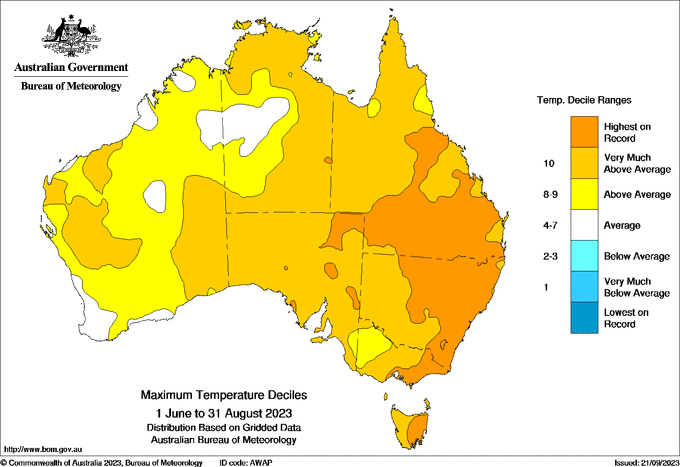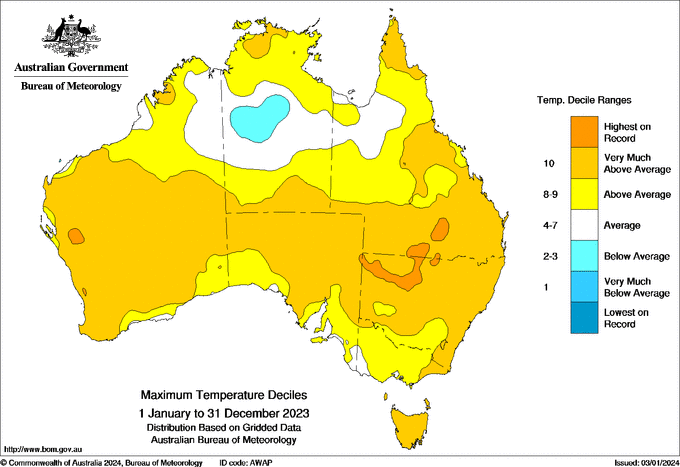Temperatures in Australia during 2023 were 0.98°C above the 1961-1990 average, making it the eighth hottest year on record. The year began relatively cooler than average, during the tail end of a “triple-dip” La Niña. In January and February 2023, several stations across Queensland and New South Wales observed their coldest summer day on record. However, summer mean temperatures around Australia were still higher than the 1961-1990 average, due to above average maximum temperatures over Western Australia, South Australia and Tasmania.
This cooler weather continued from summer into the autumn months, resulting in the coldest autumn nationally since 2012. Despite an overall cooler autumn, occasional events of very high temperatures were seen in several regions. Some sites in New South Wales, South Australia, Victoria and Queensland recorded their highest March temperatures on record between 17-21 March, when high temperatures hit most of the country. The highest were observed in north-western New South Wales with White Cliffs and Wilcannia reaching 43.8°C on 19th March. Strong cold fronts across south-eastern Australia in May caused several stations across the country to record their lowest nighttime temperature for autumn, with Canberra Airport experiencing -5.4°C on the 28th, the coldest May morning since 2015.
A major shift was observed moving into the winter months. Winter was the warmest on record for Australia since observations began in 1910, about 1.5°C higher than average (Figure 1). Almost all states and territories had records broken during this time. Queensland, New South Wales and South Australia observed their warmest winter, where mean and maximum temperatures were the highest on record. Tasmania had its highest recorded mean minimum temperature, about 20% higher than the previous record in 1988.


(1st Jan to 31st December 2023). Source: Bureau of Meteorology.
September and October brought a very warm start to spring, with the mean temperatures exceeding about 1°C of the 1961-1990 average. Western Australia had its third warmest October and November on record and its hottest spring season ever. November was among the 10th warmest for Tasmania and Queensland. Daytime temperatures were also well above average for almost all of Australia. Warmest spring maximum temperatures were recorded around Western Australia, New South Wales and parts of eastern Victoria. The very warm start to the spring season likely contributed to the heatwaves in September and primed conditions for the October bushfires in Gippsland, Victoria and south-east Queensland.
December started off with a severe heatwave that affected most of the mainland from 2-10 December 2023. Sydney Airport recorded its highest December daytime temperature of 43.5°C in 85 years. Daytime temperatures were about 10-15°C above average over most of the country while nighttime temperatures were the fifth highest on record. The month of December in 2023 was Australia’s fourth warmest December since 1910.
Overall, temperatures were above to very much above average for most of Australia in 2023 (yellow and orange parts, Figure 2), excluding certain parts in the north. These warm temperatures contributed to the several unseasonal extreme events, especially in winter and spring.
Research contacts:
Dr Sramana Neogi, sramana.neogi@monash.edu Associate Professor Sarah Perkins-Kirkpatrick, sarah.kirkpatrick@unsw.edu.au
